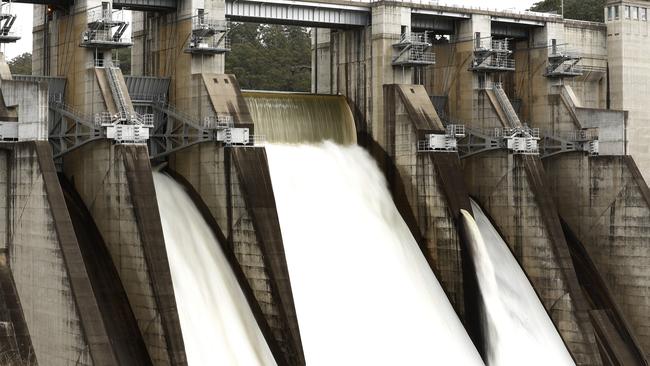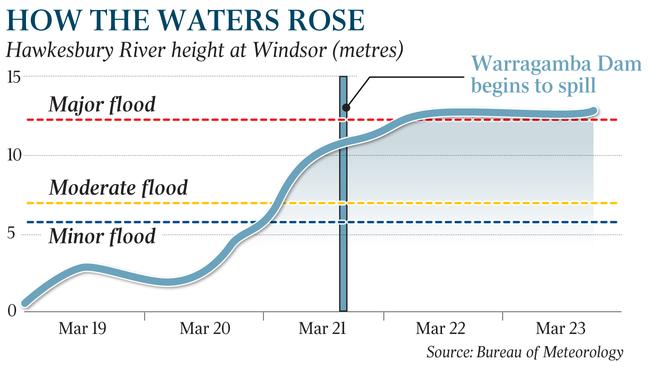
The Hawkesbury River at Windsor had already reached a height of 11m, about 1m below “major flood” level, before Warragamba started spilling on Sunday. The river has since risen to about 12.5m, where it has stabilised for the past 36 hours.
The largest recorded flood at Windsor — in 1867, almost 100 years before the Warragamba Dam was completed — exceeded 19m. So widespread was the flooding that parts of Blacktown were underwater.
Records show that the Hawkesbury River flooded just as regularly before the dam was built as since its opening in 1960.
Warragamba’s current operating procedure as a water-storage dam requires it to be kept as full as possible, allowing for small environmental releases. In the event that the dam is full, it can be lowered by up to one metre to cope with rainfall inflows, to avoid the spillway gates having to be opened. If inflows into Lake Burragorang exceed that capacity, the spillway gates automatically open in a set sequence to release water at the same rate that rainfall run-off is flowing into the reservoir from its catchment.
At the peak spill flow so far, Warragamba was releasing water at a rate of 500 gigalitres a day early on Monday, equivalent to a quarter of its full storage of 2027 gigalitres.
Introducing a flood-mitigation component to Warragamba’s operating procedures would only do so much in such an extraordinary weather system as the one that has just hit NSW. Penrith, at the base of the Blue Mountains, has recorded almost 400mm of rain in the past six days. Its annual average rainfall is 719mm.

Water NSW forecasts a total inflow into Lake Burragorang over seven days of 1500 gigalitres from this week’s downpour, equivalent to three-quarters of Warragamba Dam’s capacity.
Furthermore, the Warragamba River is just one of many rivers that flow into the Hawkesbury. Its main tributary is the Nepean, which rises in the Southern Highlands.
Requiring Water NSW to incorporate flood mitigation into its operation of Warragamba would have to be carefully balanced with its primary function as a water storage facility for a city of 5.5 million people.
Sydney’s fluctuating climate means Warragamba Dam’s level can drop fast. It fell from 96 per cent in April 2017 to almost 40 per cent in February last year, leading to severe water use restrictions being introduced in Sydney. The dam fell to almost one-third capacity in February 2007, prompting moves to build the desalination plant at Kurnell in the city’s southeast.




Warragamba Dam did not cause the flood engulfing communities in the Hawkesbury-Nepean Valley west of Sydney. An east coast low pressure system that dumped more than half a year’s worth of rain in six days did.